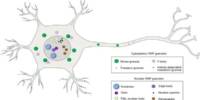Vocal learning is the ability to acquire and generate complex vocalizations by imitating the sounds of others, and it is most commonly connected with specific animal species, including humans. While the relationship between voice learning, problem-solving abilities, and brain size is complex, there is some evidence to suggest that there may be correlations and possibly causative relationships between these elements, particularly in non-human animals.
The more adept a songbird is in navigating barriers to retrieve a snack, the more complex its vocal learning abilities.
The European starling has a diverse repertoire. Starlings are versatile songbirds that learn warbles, whistles, calls, and songs throughout their lives. They are among the most advanced avian vocal learners. A new study published in Science indicates that starlings, like other complicated vocal learners, are also outstanding problem solvers.
“There is a long-standing hypothesis that only the most intelligent animals are capable of complex vocal learning,” says Jean-Nicolas Audet, a research associate in Erich Jarvis’ laboratory at Rockefeller University. “If that is true, then complex vocal learners should also be better at cognitive tasks, but no one had ever demonstrated that before.”
Our findings help support a previously unproven notion: that the evolution of a complex behavior like spoken language, which depends on vocal learning, is associated with the co-evolution of other complex behaviors.
Dr. Jarvis
Only a few animal groups are capable of complex vocal learning, which is roughly described as the ability to learn and remember a large number of sounds. Most mammalian vocal learners are humans, elephants, whales, seals, and bats, while songbirds, parrots, and hummingbirds are birds. The Jarvis lab has long been interested in songbirds and assesses their vocal learning complexity based on three criteria: how many songs and sounds the bird has in its repertoire, whether the bird can continue to learn new songs and calls throughout its life, and whether it can mimic other species.
To determine whether vocal learning is linked to different cognitive abilities in songbirds, Audet and colleagues spent three years catching hundreds of wild birds from 21 species in mist nets at The Rockefeller University Field Research Center, a sprawling 1,200 protected acres of land compromising many different ecosystems in New York’s Hudson Valley.
“It’s a protected area, which means the animals have limited exposure to humans,” says Mélanie Couture, a research assistant who worked on the study. “This is ideal for studying the behaviors of wild birds – what they can do, and how they react to cognitive tasks.”

Upon ranking the vocal learning capabilities of their subjects, three frontrunners emerged: starlings, blue jays, and gray catbirds (relatives of mockingbirds). These were also the only three capable of mimicking other species (“the epitome of vocal learning,” Audet says).
The researchers next administered a battery of cognitive tests to 214 birds from 23 different species (including two lab-raised bird species that were mixed in with the wild-caught birds). They put the birds’ problem-solving skills to the test by having them remove a lid, puncture foil, or pull a stick to obtain a treat. A transparent barrier was placed between each bird and food, and the time it took the birds to cease butting up against the barrier and move around it was recorded. Other studies looked at whether the birds could learn to identify a specific color with a food reward, as well as how quickly they adapted when the associated color changed.
Statistical analyses revealed a strong correlation between problem-solving abilities and vocal learning abilities. Starlings, bluejays, and catbirds were not only the most advanced vocal learners, but also the most adept at solving puzzles, and the better a bird was at working its way around obstacles to nab a treat, the more complex its vocal learning ability. There was no association between the other cognitive tests and vocal learning complexity.
The researchers also discovered that advanced verbal learners and problem solvers had larger brains relative to their body sizes, suggesting a biological basis for the findings. “Our next step is to look at the brains of the most complex species and try to understand why they are better at problem-solving and vocal learning,” Audet said. “We have a pretty good idea of where vocal learning happens in the brain, but it’s not yet clear where problem-solving occurs.”
Overall, the data show that voice learning, problem-solving, and brain enlargement may have developed in tandem, maybe as a means of boosting biological fitness. Based on these findings, as well as previous research on vocal learners’ ability to dance to a rhythmic beat, Jarvis has dubbed this group of characteristics the “vocal learning cognitive complex.”
“Our findings help support a previously unproven notion: that the evolution of a complex behavior like spoken language, which depends on vocal learning, is associated with co-evolution of other complex behaviors,” adds Jarvis.
















